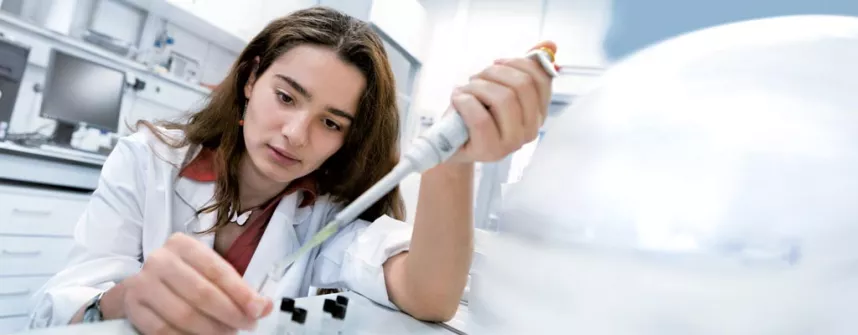Milestone in cancer diagnosis
November 23, 2015
Locating cancer cells in the body and at the same time recognizing whether they are dangerous – this dream is now one big step closer thanks to researchers at Jacobs University in Bremen and the Leibniz Institute of Molecular Pharmacology in Berlin. They have developed a method of depicting substances that indicate malignant tumors with great sensitivity. Magnetic resonance imaging, or MRI for short, is part of everyday medicine nowadays. Using magnetic fields it produces images of the inside of the human body. These can be used to help recognize pathological changes in organs, as well as tumors. This visualization depends very much on interaction with contrast agents, as has been re-confirmed by a group of researchers that includes Dr. Andreas Hennig of Jacobs University in Bremen. They discovered a molecule that improves the contrast of the images by around a hundred times in comparison with previous agents. The name of this super-candidate is cucurbituril. Magnetic resonance imaging is based on interaction between magnetic fields, radio waves and hydrogen atoms. As well as hydrogen, the process can also use the inert gas xenon to produce images of our interior workings. Specially prepared xenon, a harmless inert gas inhaled by the patient, produces signals that are revealed with far greater sensitivity in MRT than those of hydrogen. In the method that has now been developed by the scientists, the ring-shaped cucurbiturils act like a sluice. Xenon atoms are sluiced through the ring and effectively marked. The signal sent out in MRT can then clearly differentiate between areas with and without cucurbiturils. Sluicing molecules of this kind are already known. But cucurbituril can mark much more xenon in the same time and therefore makes measurement much more accurate. In their latest experiments, Hennig and his colleagues at the Leibniz Institute of Molecular Pharmacology in Berlin (FMP) have taken the sluicing trick a step further. They discovered how to open and close cucurbituril’s sluice gate at will. The key is an enzyme called lysine decarboxylase. This enzyme produces a substance which occupies the space in cucurbituril’s ring. When it is present, cucurbituril closes its sluice. As a result, less xenon can be marked, and the signal measured by MRT changes accordingly. What does all this have to do with cancer? Lysine decarboxylase is more than just the key to cucurbituril. The enzyme plays a decisive role in the growth of tumors and can indicate whether they are malignant. Hennig and his colleagues can therefore deduce the malignancy of a tumor from blocked sluices that show the presence of lysine decarboxylase. “Being able to open and close these sluices is an enormous step on the way to efficient early detection of cancer. What is especially noteworthy is how efficiently they can be opened and closed,” explains Hennig. “This is what highlights our method’s enormous potential for medicine. Xenon MRT, ideally conducted with a range of contrast agents that mark different types of cells, could reveal even small tumorous lesions clearly and permit individual diagnoses without any biopsy at all. This method also has a significant advantage over conventional radioactive contrast agents because it doesn’t expose patients to any significant radiation.” But it isn’t entirely ready to use. Further studies will be required to bring the method out of the test tube and to the patient. Hennig and his colleague Dr. Leif Schröder of FMP firstly want to improve the sensitivity of measurement in cell cultures. They also need to be able to operate the enzyme key more precisely, and look for other key molecules. “Our initial experiments with cucurbituril were something of a shot in the dark. The method we came up with is much more sensitive than we had ever imagined it would be. It was an enormous surprise for us as well,” explains Hennig. “This is a milestone in cancer diagnosis which we now intend to pursue hard.” Original publications:Matthias Schnurr, Jagoda Sloniec-Myszk, Jörg Döpfert, Leif Schröder, and Andreas Hennig: Supramolekulare Assays zur Lokalisation von Enzymaktivität durch Verdrängungs-induzierte Änderungen in der Magnetisierungstransfer-NMR-Spektroskopie mit hyperpolarisiertem 129Xe. (Supramolecular assays for localizing enzyme activity by means of displacement induced changes in magnetization transfer NMR spectroscopy using hyperpolarized 129Xe.) Angewandte Chemie, in press (2015). German edition: DOI: 10.1002/ange.201507002International edition: DOI: 10.1002/anie.20150700 Identification, classification, and signal amplification capabilities of high-turnover gas binding hosts in ultra-sensitive NMR. Chemical Science, 2015, 6, 6069 – 6075. DOI: 10.1039/C5SC01400J Enquiries: Dr. Andreas Hennig | Department of Life Sciences and Chemistrya.hennig [at] jacobs-university.de | Tel.: +49 421 200-3625
